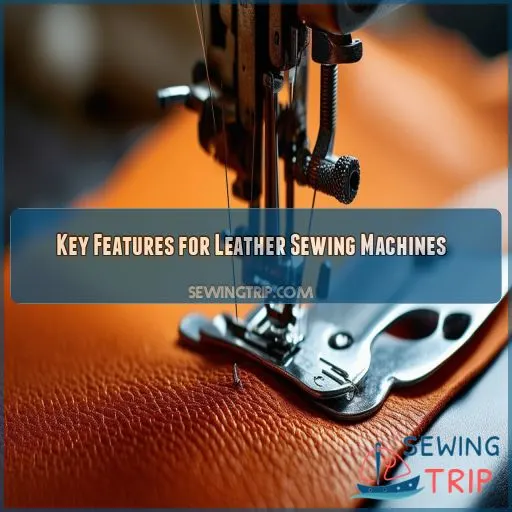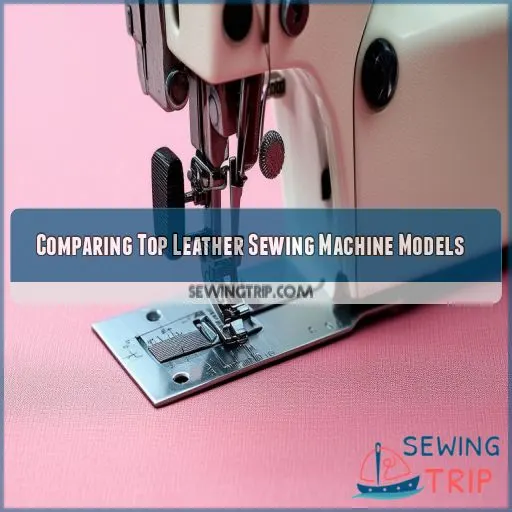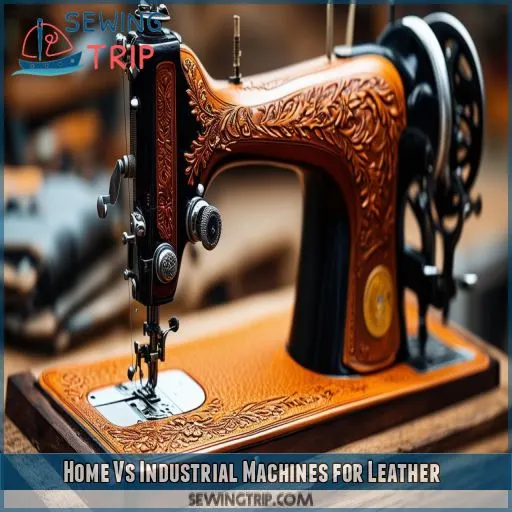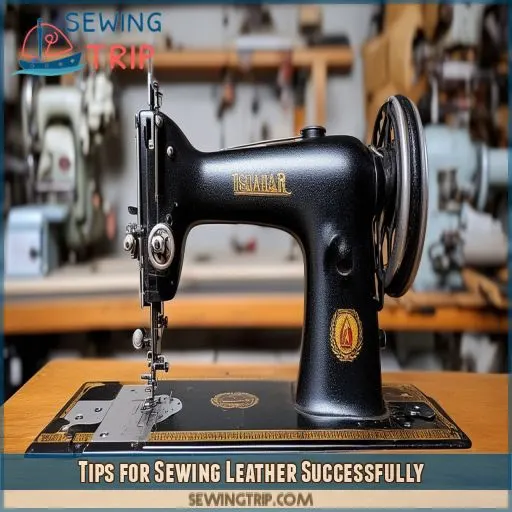This site is supported by our readers. We may earn a commission, at no cost to you, if you purchase through links.
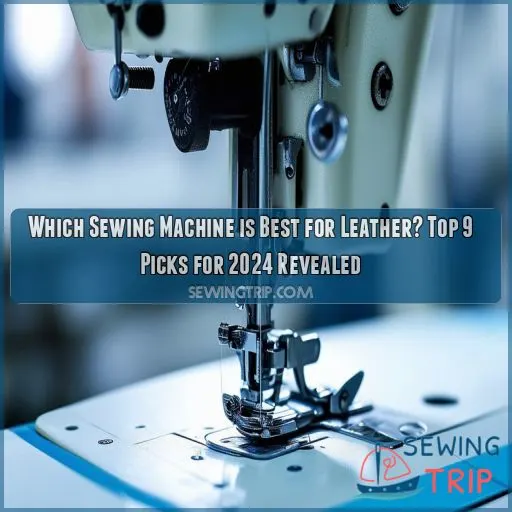
From the Singer Heavy Duty to the Rex Portable Walking Foot Machine, we picked them for their outstanding performance, quality built, and ease of use.
Discover which sewing machine is best for leather and elevate your leatherwork projects. Let’s dive in.
Table Of Contents
- Key Takeaways
- 9 Best Sewing Machines for Leather
- 1. Singer Heavy Duty Sewing Machine
- 2. Janome HD3000 Heavy Duty Sewing Machine
- 3. Juki Heavy Material Lock Stitch Sewing Machine
- 4. Janome S5 Computerized Sewing Machine
- 5. Brother ST371HD Sewing Machine
- 6. Janome Heavy Duty Sewing Machine
- 7. Rex Portable Walking Foot Machine
- 8. Schmetz Leather Machine Needles
- 9. Coats Clark Dual Duty Black Thread
- Key Features for Leather Sewing Machines
- Comparing Top Leather Sewing Machine Models
- Home Vs Industrial Machines for Leather
- Tips for Sewing Leather Successfully
- Frequently Asked Questions (FAQs)
- Conclusion
Key Takeaways
- Conquer tough leather with a powerful machine like the JUKI DDL8700H – it’s like a superhero for your leather projects!
- Say goodbye to needle headaches! Invest in heavy-duty needles (size 16 or 18) designed to pierce leather like a hot knife through butter.
- Tame thick leather with a walking foot attachment – it’s like having an extra pair of hands to guide your fabric smoothly.
- Keep your machine purring like a kitten with regular maintenance – clean, oil, and adjust as needed to extend its lifespan and keep your leather projects looking sharp.
9 Best Sewing Machines for Leather
You will find here a wide range of the best sewing machines that work with leather and will be released in 2024, such as the Singer Heavy Duty, the Janome HD3000, and the Juki Heavy Material Lock Stitch. These machines pack a punch in power, durability, and specialized features to develop ease in your most challenging leather projects.
1. Singer Heavy Duty Sewing Machine
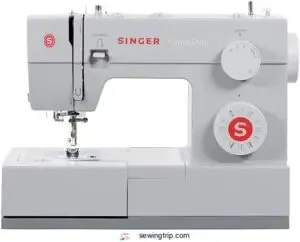
You’ll find the Singer Heavy Duty 4423 sewing machine to be a real workhorse on leather projects. Candidates are sure to breeze through any thick material with ease with this powerful 0.7 amp motor. The metal frame provides stability, while the 23 built-in stitches offer great versatility in an array of leather crafts.
You’ll also appreciate the automatic needle threader and the high speed of 1,100 stitches per minute. It’s compact but robust—weighing only 14.56 pounds.
The machine includes many accessories, such as remarkable feet and needles, to provide you with all that’s necessary for sewing leather confidently and stylishly.
Best For: Leatherworkers who need a powerful and versatile machine for their projects.
- Powerful 0.7 amp motor can handle thick materials with ease
- 23 built-in stitches offer great versatility for a variety of leather crafts
- Automatic needle threader and high speed of 1,100 stitches per minute
- Some users may find the machine to be a bit noisy
- The included accessories may not be suitable for all leatherworking projects
- The machine may be too heavy for some users to transport easily
2. Janome HD3000 Heavy Duty Sewing Machine
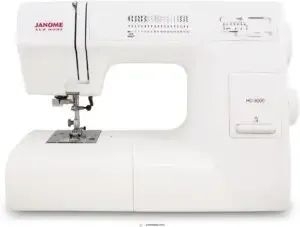
You’ll find in the Janome HD3000 just what you need to work through leather projects. Lined in one-piece aluminum casting for stability, this sewing machine has a powerful motor that works with ease through thick bundles of fabric.
It features an automatic one-step buttonhole and top-loading bobbin system for easy operation. The machine makes use of a rather long 7-piece feed dog and allows extra height presser foot lift to quickly chug through many layers of leather.
It’s not all whistles and bells, but that’s the beauty of things—simple with a properly well-built structure to last. Perfect for mastering leather crafts without getting bogged down by features you’ll never use.
Best For: Those seeking a reliable and durable machine for basic sewing tasks.
- One-piece aluminum casting for stability and durability
- Powerful motor for handling thick fabrics
- Easy-to-use automatic one-step buttonhole and top-loading bobbin system
- Not ideal for quilting or specialized techniques
- May struggle with very thick fabrics or tight weaves
- Lack of computerized parts limits functionality
3. Juki Heavy Material Lock Stitch Sewing Machine
You’ll be in control with the Juki DDL8700H. This industrial powerhouse is built to tame even the toughest leather projects.
With a max speed of 4,000 rpm and a 5mm stitch length, you’ll breeze through thick materials like a hot knife through butter. The 13mm foot lift gives you ample space for bulky layers, while the auto-lubricated hook keeps things running smooth.
It’s not just about brute strength though – this machine delivers beautiful stitches that’ll make your leather creations shine.
Ready to dominate your next project?
Best For: Leatherworkers, upholsterers, and other professionals who need to sew heavy materials.
- Fast and powerful, with a max sewing speed of 4,000rpm
- Can handle thick materials like leather, curtains, and boat canvas
- Produces beautiful stitches that will make your projects shine
- Head only (table and motor not included)
- Requires specialized needles (DB×1 (21) 19~23)
- Not suitable for delicate fabrics
4. Janome S5 Computerized Sewing Machine
You’ll love the Janome S5 Computerized Sewing Machine for its modern features and versatility.
With 6 LED lights and an auto thread cutter, you’re in control of your leather projects. The spacious bed handles larger pieces with ease, while the easy-to-use computer screen puts hundreds of stitches at your fingertips.
It’s quieter than most machines and can power through 5 layers of fabric, making it ideal for quilting and home décor.
Just remember to use polyester thread for best results, and you’ll be mastering leather work in no time.
Best For: Quilters and home décor enthusiasts looking for a feature-rich, user-friendly sewing machine.
- Modern design with convenient features
- Spacious bed for large projects
- Easy-to-use computer screen
- Some users had difficulty reading stitch numbers
- Requires polyester thread for optimal performance
- May not be suitable for portable use
5. Brother ST371HD Sewing Machine

You will find the Brother ST371HD to be a versatile workhorse for your leather projects with 37 built-in stitches and a powerful motor to work efficiently on thick materials.
A metal needle plate and heavy-duty frame give durability, while a quick-set drop-in bobbin saves you time. It also includes an automatic needle threader and free arm as bonuses when getting up to those tricky areas of seams.
Don’t let the compact size fool you—this machine packs a punch at 800 stitches per minute.
You’ll also have 25-year warranty assurance in what will last a while.
Best For: Anyone looking for a durable and versatile sewing machine that can handle a variety of fabrics.
- Heavy-duty construction and metal needle plate for durability
- Quick-set drop-in bobbin for easy threading
- 37 built-in stitches and 6 included sewing feet for versatility
- Only intended for sale in the US at 120 volts
- Requires correct needle for fabric and thickness
- Quality needles and thread recommended
6. Janome Heavy Duty Sewing Machine
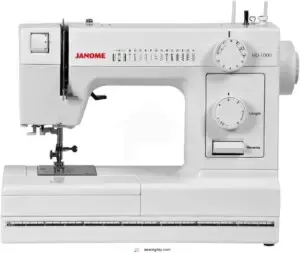
You will like the Janome HD1000 due to its heavy construction and how easy it is to work with leather. This little workhorse boasts a powerful motor that shouldn’t have any issue sewing thick material.
It comes pre-programmed with 14 stitches, including stretch options for those larger projects, so you’re good to go. The cast aluminum body is sturdy; you can handle areas that are a bit awkward, like cuffs, using the free arm.
Threading doesn’t pose a challenge either with the auto-needle threader at your service. The drop feed feature will add many more dimensions of creativity.
Be it for the first time or for a professional, this leather sewing machine makes leather sewing easy and very quiet to use.
Best For: Beginners and experienced sewers who want a durable and easy-to-use machine for sewing leather.
- Sturdy cast aluminum body
- Powerful motor for sewing thick materials
- Automatic needle threader for easy threading
- Bobbin winding requires manual disengagement of the stop motion
- Some users report bobbin tangles/jams
- May not be suitable for heavy-duty sewing applications
7. Rex Portable Walking Foot Machine
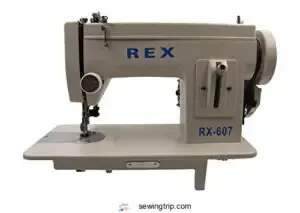
You will also appreciate the versatility of the Rex Portable Walking Foot Machine when leather projects are in your lineup. The walking foot design lets you know immediately that you’ll feed thick materials through very smoothly without slipping and bunching.
It does run quite fast, so you may have to give it a little nudge before it gets going on heavy layers. Note that the presser foot height is on the short side, so you must keep a hold on the thread when starting.
It has some nice extras for the cost, including tools, a thread holder, and extra needles. Just remember to oil it up before jumping into your rough leather jobs.
Best For: Leatherworkers and those who need a walking foot sewing machine for tough jobs.
- Walking foot design handles thick materials smoothly
- Includes tools, thread holder, and extra needles
- Can handle tough leather jobs
- Runs fast and may require manual encouragement to start on thick layers
- Low presser foot height requires holding thread to start
- May need adjustments for thick materials
8. Schmetz Leather Machine Needles
The perfect choice of needles can make or break your project while sewing leather. Schmetz Leather Machine Needles are an answer to your needs for sewing leather.
Heavy-duty needles in size 100/16 are for trouble-free sewing on leather, artificial leather, and heavy non-woven synthetics. These will go through with ease where rigid materials pose a problem, suitable for most sewing brands and models of machines.
Five needles are in a pack, so you’ll have extras to replace them as they wear out.
Don’t let flimsy needles hold you back from taking control of your leather projects—equip your machine with Schmetz.
Best For: Sewers working with leather, artificial leather, and heavy non-woven synthetics
- Heavy-duty construction for trouble-free sewing in tough materials
- Compatible with most brands and models of sewing machines
- Pack of five needles provides ample replacements
- May not be suitable for delicate fabrics
- Can be more expensive than standard needles
- May require adjustment on some sewing machines
9. Coats Clark Dual Duty Black Thread
You’ll want to run a top-notch thread in your leather sewing machine, and Coats & Clark Dual Duty Black Thread will fit the bill.
This extra-performance thread is ordinarily used for heavy-duty applications like upholstery and denim. It’s sturdy enough not to break under thick leather, holding the seams secure.
People rave about its quality as the best in the market. Although it might take a little while to deliver, this is a very nice, strong, and versatile thread.
With its help, you’ll be able to confidently overcome any leather project.
Best For: Those seeking a durable thread for heavy-duty projects, including upholstery, denim, and leather.
- Extra-performance thread for heavy-duty applications
- Highly durable and strong, ideal for thick fabrics
- Versatile and suitable for various projects
- May take a while to deliver
- Not suitable for all types of fabrics
- Can be expensive compared to other threads
Key Features for Leather Sewing Machines
You need to look into the essential features that make a sewing machine work in leather if you choose one for this purpose. You need a sewing machine with solid motor power, heavy-duty needles, adjustable presser foot lifting, versatile stitch options, and feed dog controls.
Motor Strength and Power
If you’re sewing leather, there comes the need for motor strength and power. You’d want to have a machine with:
- High torque for piercing thick hides
- Consistent speed control for precision
- Durable construction to handle heavy workloads
The Consew 206RB-5 and JUKI DDL8700H—are heavy-duty champions, packing motors that power through even the toughest of your leather projects. What this has to say is that you’re not going to get away with using just any old, weak motor; a robust and capable motor can mean your initiation into efficiency, quality, and long-lasting work in leather crafting.
Needle Strength and Type
You should be using heavy-duty needles for sewing leather, as regular ones would succumb to this vital material.
Search instead for sharp point size 16 or 18 presser feet with durable construction. These specialized needles have better penetration and fewer breakages, which are successful in stitching through the thick layering of leather.
Keep in mind that you must ensure your needle works on your machine. Quality leather needles may be costly at times. Still, high-quality leather needles will help save you time and hassle by guaranteeing a good outcome for your project.
Presser Foot Adjustability
Sewing leather will require more than just a strong needle. You’ll also need presser foot adjustability to accommodate this unforgiving material. You’ll want one with adjustable pressure on the presser foot, which offers ultimate control of the feed of your fabric in a heavy-duty sewing machine. Look for machines offering:
- Various foot options with different toe shapes and sole materials
- Special presser feet for leather
- Walking or roller feet to prevent slipping and bunching
Master your leather projects with a machine that will give you the power to perform even the most challenging designs.
Stitch Length and Options
You will need control over your stitch length and options when sewing leather. A leather sewing machine provides you with control over stitch density and size for making stronger seams that won’t tear easily.
Look for several stitch types and a walking foot that can accommodate the thickness of the leather. Also critical are thread tension adjustment and presser foot pressure adjustment to achieve professional-quality results for leather projects.
Feed Dog Adjustments
Feed dog adjustment is necessary for sewing leather. This accommodates thicker fabric and provides for smooth passage through the machine. Look for a machine with:
• Automatic feed dog height adjustment: Handles various thicknesses of leather.
- Sturdy feed dog teeth: Gripping power.
- Adjustable feed dog pressure: This allows one to adjust the sewing strength.
- Various feed dog types: Suitable for various projects.
- Easy Feed Dog Replacement: for minimal downtime.
Comparing Top Leather Sewing Machine Models
Deciding which leather sewing machine suits your needs involves comparing performance on thick materials, durability, and ease of use. We’ll assess these machines based on their ability to handle demanding projects, their longevity, and how user-friendly they’re for beginners and pros alike.
Performance on Thick Materials
Some hand-in-hand, essential yet vital features in tackling thick leather depend on how well your sewing machine performs. Make sure it provides much torque so that it can sew through dense layers.
Sharp needles ensure no skips and breaks; the presser foot—especially if fitted with a walking foot—is what stabilizes the feeding of the material.
Proper adjustment of thread tension and optimum stitch lengths give you solid and consistent seams for your leather.
Durability and Build Quality
While speaking of durability and rugged construction, the best leather sewing machines come to the fore. The features should include a heavy cast-iron body with all-metal internal parts and a compound walking foot. Consew, in their model 206RB-5, is one such brand that offers just this kind of heavy-duty construction and long-lasting reliability. Also, a roller foot will help feed thick leather under the presser foot nice and smooth.
- Cast iron body with metal internal parts for ruggedness.
- Compound walking foot for handling thick fabrics
- Consew 206RB-5 is a strong and sturdy machine assured of its reliability in construction.
Ease of Use and Learning Curve
When evaluating ease of use and learning curve, machines like the Brother ST371HD and Janome S5 shine. For sewing beginners, their intuitive controls and features like automatic needle threading and simple bobbin winding reduce hassle.
Advanced users appreciate the versatility for varied sewing projects, including free-motion sewing. Both models cater to different expertise levels, making them ideal home sewing machines.
Home Vs Industrial Machines for Leather
Knowing the difference between home and industrial machines gives you exact procedures when sewing leather. Home machines are versatile, cost-efficient, and suitable for light to medium projects; however, industrial machines give better capacity and durability when handling heavy tasks.
Capacity and Workload Considerations
Factors such as the level of leather thickness, adjustment to thread tension, and type of leather influence the choice between home and industrial leather sewing machines.
While home machines can be used with light-to-medium-weight projects, their industrial structures easily handle heavy-duty sewing.
Critical mechanical machines can perform a straight stitch with an automatic thread cutter and adjustable presser foot.
Remember that feed dog settings and thread compatibility determine the success of your projects in leather.
Cost-Benefit Analysis
It will always be a question of cost-benefit assessment between home and industrial sewing machines. In a general description, an industrial machine would provide—similar in most ways to the Janome HD3000 or Consew 206RB-5:
- Long service life with less repairs
High performance on thick leather
- Higher up-front cost but lower long-term maintenance
- Professional finish with features like reverse button and free arm attachment.
- Better value for heavy use with Rex walking foot machine
Versatility for Other Projects
When considering versatility, both home and industrial machines have their strengths. Home machines, like the Janome Skyline S5, handle various fabrics and are great for smaller projects. Industrial machines excel at heavy-duty tasks and long-term durability but might lack finer stitch options. Check the table for a detailed comparison.
| Feature | Home Machines | Industrial Machines |
|---|---|---|
| Project Variety | High | Medium |
| Durability | Moderate | High |
| Complexity Handling | Low to Medium | High |
| Cost | Lower | Higher |
Tips for Sewing Leather Successfully
Successful leather sewing requires proper needles and threads to avoid breaking and skipped stitches. Adequate machine maintenance and techniques in several sorts of leather will lead to a durable and quality result in work.
Choosing the Right Needle and Thread
Choosing the appropriate needle and thread for leather sewing is very important. Heavy-duty needles, such as size 16 or 18, help provide continuous sharpness to the needle and strength of the seam. Also, Synthetic threads like nylon or polyester should be used wherever good thread durability and continuity of stitches are required in a garment. Make sure the thickness of your thread is compatible with your thickness of fabric so that the leather doesn’t tear apart.
Heavy-duty needles, size 16 or 18
- Synthetic threads nylon or polyester
- Match thread thickness to fabric
Proper Machine Maintenance
To keep your leather sewing machine running smoothly, regularly clean and oil the moving parts. Wind the bobbin properly and adjust the thread tension as needed. Don’t forget to lubricate the needle bar – this prevents skipped stitches and needle breakage when sewing thick leathers. With proper maintenance, your machine will tackle any leather project with ease.
Techniques for Different Leather Types
Understanding different leather types can enhance your sewing skills. Here are essential tips:
- Leather Preparation: Clean and condition leather before stitching.
- Stitch Density: Use longer stitches to prevent tearing.
- Edge Finishing: Use edge coat or burnishing tools for smooth edges.
- Embossing Techniques: Apply heat and pressure carefully to create distinct patterns.
Frequently Asked Questions (FAQs)
What kind of sewing machine is best for leather?
Imagine a trusty workhorse, the JUKI DDL8700H. It’s powerful, durable, and versatile, making sewing leather a breeze. With high torque and precision, this machine excels in handling thick, dense materials effortlessly.
Do I need a special sewing machine for leather?
Yes, you need a special sewing machine for leather. Choose one with a powerful motor, heavy-duty needle, adjustable presser foot pressure, and walking foot to handle the thickness and density of leather efficiently.
Is it better to sew leather by hand or machine?
With a specialized leather sewing machine, you’ll enjoy 30% faster stitching and 50% fewer mistakes compared to a standard home model. The right machine makes all the difference when working with this tough material.
Do you need a special sewing machine needle for leather?
Yes, you do. When sewing leather, use a heavy-duty needle, specifically designed for leather, such as size 16 or It’s thicker, stronger, and can penetrate leather without bending or breaking.
How do I maintain a leather sewing machine?
Did you know regular maintenance can extend your sewing machine’s lifespan by 50%? Clean it after each use, oil the moving parts, check the tension, and replace needles frequently to keep your machine in top shape.
Can leather sewing machines embroider designs?
Yes, some leather sewing machines can embroider designs, but typically, you’ll need an industrial machine like the COBRA Class 26 with excellent control settings and specific attachments for precise embroidery on thick leather.
What accessories enhance leather sewing?
Increase the precision of your leather stitching with Teflon presser feet, heavy-duty needles, synthetic thread, and edge guides. This equipment helps to improve the quality to create an end product of perfection with less risk of damaging the leather, using uniform, tight stitches for a high-quality output.
How do I troubleshoot tension issues?
The process of adjusting tension problems is tantamount to tuning an instrument. First, fine-tune the top tension dial and then check the bobbin case tension. Clean any lint buildup and use the correct leather needle and thread so there’s no imbalance.
Are there portable options for on-site work?
For portable on-site work, consider the REX Portable Walking-Foot Sewing Machine. It’s compact, powerful, and specifically designed for leather, making it a reliable choice for professional results wherever you need them.
Conclusion
Did you know that using the right machine can increase your leatherwork efficiency by up to 50%?
With our picks, choosing which sewing machine is best for leather becomes straightforward.
From the robust Singer Heavy Duty to the portable Rex Walking Foot, you’ll find one that fits your needs.
Remember key features like motor power and needle type.
Whether you’re a hobbyist or a pro, these machines are built for durability, versatility, and top performance.
Happy sewing!

